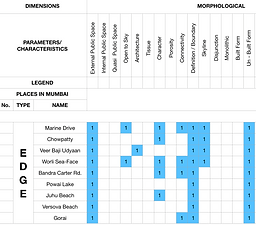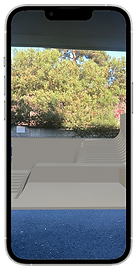
Urban Place-Making
Role of architecture in the process of making "Places"
Academic | Mumbai University | Undergraduate Thesis | 2017 - 2018
Instructor: Tripti Biswas | Daniel D'Souza
Bandra Kurla Complex | Mumbai | India
Progam: A Public Hub
“We move through a space; we stop in & are directly involved with places”- Yencken (1995)
The concept of ‘place’ is a way of relating physical space with human aspects. Any urban form, which carries with it imprints of urban life, becomes a place; be it a building, a street, a market or an entire neighborhood. The relative permanence of an urban space helps establish its qualities as a meaningful place. The physicality provides a tangible record or the passage of time & embodies social memory. Impermanence is however, antithetical to placemaking as its importance is attached to considerations of sustainability. Place-making looks at the city on a human scale & re-builds it for human beings rather than just cars, buses & trains. This thesis investigates the role of architecture in increasing the quality of people’s experiences of everyday life in the public domain, and to explore opportunities to re-frame a non-place in the city of Mumbai, by imbuing ‘The Architecture of Place’ with a ‘Sense of Place’ in the urban district of BKC in the city of Mumbai. An architectural object with its obvious nature of creating a powerful public presence is used as a tool for place-making to transform a non-place like BKC into a vibrant district by creating a system of ‘people-places’ throughout the district.
This thesis addresses the following questions:
1.Has architecture lost its ability of place-making?
2.How can architecture interact with the urban fabric to favour urbanity & enhance a place’s resilience?
3.How do experiences change user perceptions from a ‘non-place’ into a ‘place’?
4.How can non-places be adopted, redefined & re-calibrated to play a more important role in the fabric of a city?
5.How can movement & behaviour of people determine the design, definition, form & notion of a place ?
Research & Analysis
What makes a PLACE?
X-Axis: Characteristics | Y-Axis: Imagibility

Keywords are used as parameters for the quantitative analysis of public places in Mumbai as shown in the table below. The keywords are clustered around the basic dimensions of public places - morphological, perceptual, social, visual, functional & temporal. These terms help in describing how a particular place looks, feels, sounds, performs, functions, behaves or acts.




Multiple Imageablility
Places are further analyzed in terms of its context & the five different elements of Kevin Lynch's principles of Imageability. Multiple Imageability: ability of a place to behave as two or more different elements; for example: a path (primary element) consisting of nodes & landmarks (secondary elements) predominantly within itself.

Context Study
A space becomes a place due to a combination of multiple elements- edges, paths, nodes, landmarks, districts. The dominant element varies according to the user depending on his perceptions & needs. Elements of the city therefore contain elements within themselves. Hence PLACES exhibit Multiple Imageability in the city. Places which do not exhibit multiple imageability can be called as Non-Places.




Mapping & Analysis




Design Proposal
Activating the District






Urban Strategy & Design (Scroll below for AR)

Experience in AR
Shaded Walkway



Viewing Deck


Pavillion


Bus Stop


Taxi Stand


Transit Shelter


Public Hub
The project envisages this site to function as a city level public ensemble at the same time keeping in mind the immediate local environment by insertion of a socio- cultural & recreational layer of an informal nature amidst the extremely formal nature of the existing commercial layer. It considers the upcoming ILFS Metro Station next to the site at BKC to perform as a catalyst for the public hub. The design intends to be immersive & highly experiential yet speak to its eternal values of ‘places’- streets as the sociable spaces of city, experience through the path, connect to the outdoor, multiple movement patterns, public interface. It also intends to create an identity for the district with a stronger appearance, generating a sense of place.










Detail Drawings












